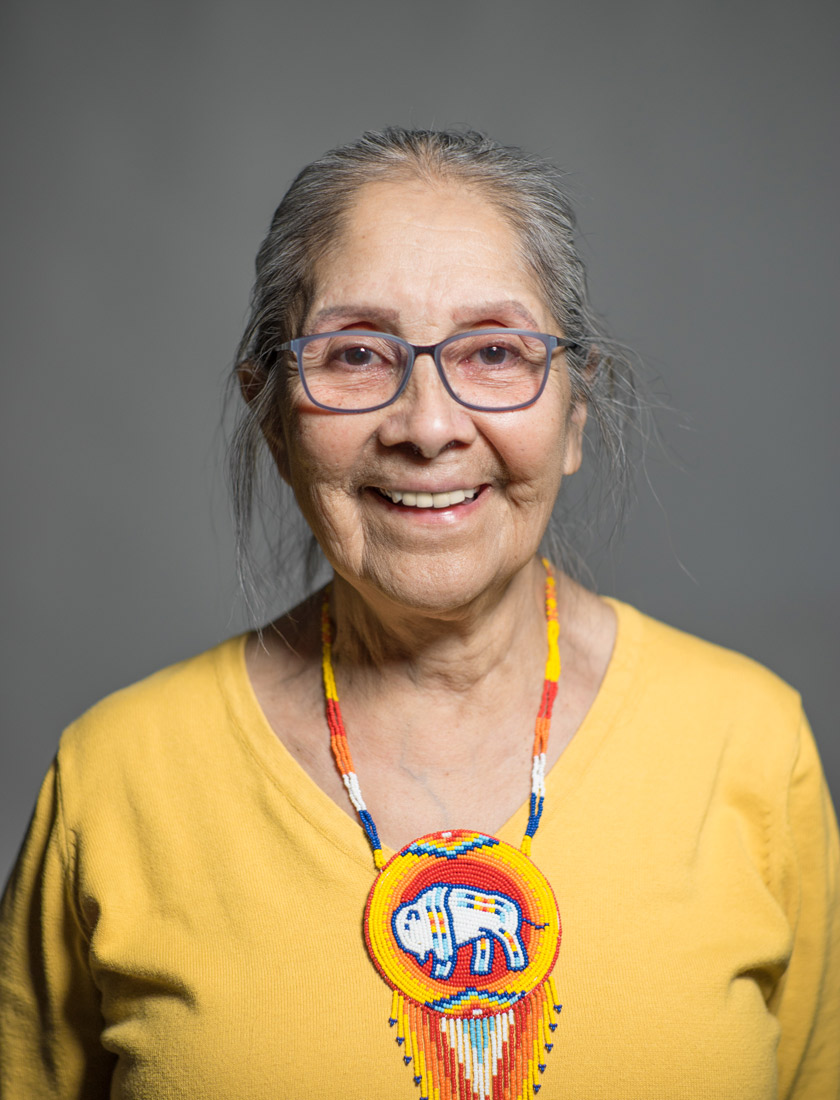Lynda Minoose, ’91 BEd, ’12 Cert(ComLing), conducted a survey in 2007 to find out how many people in her community spoke and understood Denesųłįné — the traditional language of her community and one she has spoken all her life. When she told Cold Lake First Nations’ chief and council that she’d found only 118 people out of 4,000, they hired her to head the first Denesųłįné Language and Culture Department on Cold Lake First Nations. Minoose enrolled in the Canadian Indigenous Languages and Literacy Development Institute (CILLDI) at the U of A to expand her tool kit. She learned linguistic analysis, policy planning and tech skills to help integrate Denesųłįné back into her community. Here are some of the things she has learned about preserving and revitalizing Indigenous languages.
1: Learning has no age limit
In the past 10 years, Minoose, age 72, has earned a master’s degree and a Community Linguist Certificate, and has dubbed herself a “techno-granny.” At CILLDI, she was introduced to digital tools ranging from PowerPoint to language software. Now, she has helped publish nine storybooks, a 3,000-word dictionary and a language app, all to support Denesųłįné learners. “As long as I have the physical capability and the mind, then I have something to contribute,” she says. “I’ve always wanted to do something for my community and this is it.”
2: You need to have heart
Today, there are around 60 Denesųłįné speakers left in Cold Lake First Nations. But this doesn’t discourage Minoose — it motivates her. “There’s a deep current that drives me,” she says. “And it’s my passion. I’ve taken on this work, and have continued with it as long as I have, because this is what I’m supposed to do with my life.” Her goal is to pass on that passion to the young people in her community. She started a language nest, a two-year immersion-based language revitalization program for families with young children. In the program, two elders speak to preschoolers only in Denesųłįné, so the children hear the language at an early age. “This is where I’m supposed to be. I know it. I feel it in my heart.”
3: Language is alive
Language is more than words and letters. Minoose says that because she understands Denesųłįné, she can better understand her peoples’ worldview, way of life and history. Her focus on reviving cultural traditions like birch bark basket making, hide tanning, drumming, smudging and medicine harvesting are all part of the revitalization process. “Language lives in the people who speak it and in their traditions,” she says. “Everybody is equipped to learn their language, because the language is in our DNA. It’s in our soul memory. It’s in everything we do.”
4: Revitalization is a team effort
Minoose says there are many ways for Indigenous and non-Indigenous people to help revitalize Indigenous languages. She has more goals than available help. For example, she wants to get her Denesųłįné dictionary online and functioning intuitively, to update the app, and to open a cultural interpretive centre in Cold Lake. All of these projects require funding, willing professionals with technical know-how, or both. It would be a dream, she says, to connect with experts — such as web developers, historians, archivists, curators, curriculum developers and researchers — who are willing to teach and guide her and others. “Above all, we need people to get together,” she says, “to work together, to create more dialogue and share our skills.”
5: It takes time
The revitalization of a language doesn’t happen overnight. It takes perseverance, patience and, most of all, time. In 2019, when the United Nations declared the International Year of Indigenous Languages, 40 per cent of the estimated 6,700 languages spoken around the world were in danger of disappearing. Minoose is working hard to pass her torch to the next generation to create a future where Denesųłįné is spoken commonly in her community. “It took the government 150 years to try to eradicate our languages,” she says. “So, it would be safe to say we need the support for 150 years to bring it back.”

We at New Trail welcome your comments. Robust debate and criticism are encouraged, provided it is respectful. We reserve the right to reject comments, images or links that attack ethnicity, nationality, religion, gender or sexual orientation; that include offensive language, threats, spam; are fraudulent or defamatory; infringe on copyright or trademarks; and that just generally aren’t very nice. Discussion is monitored and violation of these guidelines will result in comments being disabled.